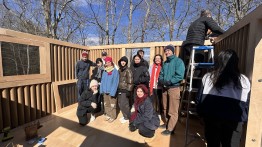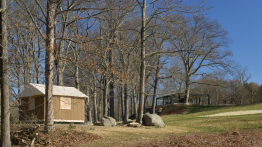Cooper Students Construct Ban’s Paper Log House
POSTED ON: May 1, 2024
For the first time in six years, Shigeru Ban’s Paper Log House will be on view in North America thanks to the efforts of a set of Cooper architecture students, faculty, and alumni, including Ban himself, a 1984 graduate. Students fabricated the components of the house and eventually assembled it on the grounds of Philip Johnson’s Glass House campus.
“It’s extremely special that we could have so many students working together productively on a single project—quite an unusual and extraordinary opportunity and the students performed extremely well,” said Dean Maltz, a principal at the firm.
Every year, the Glass House organization selects one architect or artist to be featured on the 49-acre campus. This year’s honoree, Pritzker Award–winner Shigeru Ban, is renowned for his innovative use of paper to build quickly constructed shelters for victims of disasters. The first of these was the Paper Log House, which will be featured as part of the Glass House exhibition on Ban’s career. Ban and Maltz, himself a 1984 Cooper graduate, thought it natural to give the students of their alma mater a hands-on opportunity in construction. “Cooper architecture students have a reputation for being extremely good craftsmen, and they exhibited that high level of quality with the production of the Paper Log House,” said Maltz.
The curators of the exhibition chose to feature the house since, as they wrote on the Glass House website, “Shigeru Ban’s inventive work alongside The Glass House challenges preconceived notions of permanence and material strength. Visitors will be able to consider the value of both historic preservation and permanence in glass and brick juxtaposed with temporary, recyclable, and movable structures made of paper and cardboard.”
In 1995, Ban, looking for existing materials that could quickly be converted into emergency housing for survivors of the Kobe earthquake, hit on the idea of using prefabricated paper tubes as a house’s essential module to provide sustainable, temporary housing for victims of disaster. The Paper Log House has been constructed to house refugees of war and natural disasters across five continents.
For this latest iteration, Ban’s firm teamed with Professor Samuel Anderson who teaches Building Technology, a third-year course that runs for two semesters. During Spring 2024, class members along with volunteers from Cooper’s first- and fourth-year architecture classes, worked from Ban’s drawings to fabricate necessary parts such as components in the AACE Lab and wood shop; constructed the house on the Great Hall stage as a rehearsal for the final build; disassembled the house and packed it for transport; then traveled to Connecticut where they rebuilt the shelter for its 8-month life on the Glass House campus.
The house is constructed of walls made of paper tubes treated with three coats of polyurethane for waterproofing, a canvas roof, and a plywood floor attached via zip ties to a grid of milk crates. Those are weighed down with sandbags to ground the structure in case of heavy winds. Anderson said, “A huge amount of labor went into creating everything so that it wouldn’t warp or bloat in the rain.”
EG Rheams, a third-year architecture student who helped waterproof fthe building, worked on the walls/tube group to construct holes in the tubes that were later fitted with metal rods. The experience was the first time Rheams had built a structure on a 1-to-1 scale and had the chance to see the vicissitudes of construction up close. “Troubleshooting and problem solving became very important. Teamwork and organization were instrumental in this project,” Rheams reported.
During the previous semester of Anderson’s Building Technology course, students had built a large-scale mockup of a detail that intrigued them from a work of architecture. “So they got a bunch of experience getting their hands dirty with real construction materials,” he said.
But the design of the Paper Log House presented them with new challenges since they were creating elements that needed to fit perfectly with only a minimal allowance for discrepancy. For instance, students had to drill 5/16-inch holes in paper tubes to fit a ¼-inch metal rod. That is, a 1/16-inch margin of error. “I was astonished that there were no tolerances,” Anderson said, referring to the amount of leeway in building measurements. “It made life for the students very difficult.”
Helena Uceda, a first-year architecture student who volunteered to be part of the build, attests to the challenges and excitement of the project. “There is a lot of communication necessary with division of labor, and organization in terms of schedules and tasks. I also learned about all the things that could possibly go wrong. We encountered extensive issues throughout the entire process, things that could not be foreseen, and had to be worked on along the way.”
Over the course of a weekend in February, students assembled their paper log house on the stage of the Great Hall. Uceda found the test run invaluable for learning the construction process and troubleshooting before going to the Glass House site. But she and her colleagues, like third-year architecture student Meztli Castro Asmussen learned even more about the interplay between site and building when, upon arriving at New Canaan, new problems arose during the students’ final assembly: “The wood of the door was warped, the floorboards no longer aligned how they had at school, the site was not level, an issue that was worse than anticipated,” Uceda said. Asmussen added, “Because we were building the house at a one-to-one scale, we were able to see how pieces came together in a way that drawings struggle to illustrate. We also learned, perhaps the hard way, the importance of tolerance, and what it means to design within, and without tolerance. The difference between an eighth inch thick tape and a quarter inch thick tape adds a significant amount of length to the entirety of the wall.” In short, it was a master class in improvisation and collaboration that the best studio and classroom work couldn’t have provided.
“It was a very educational experience for me as a first year,” Uceda noted. “I had never embarked on such an intensive construction project.”
The Paper Log House will be on view on the Glass House campus from April 15–December 15th, 2024.






